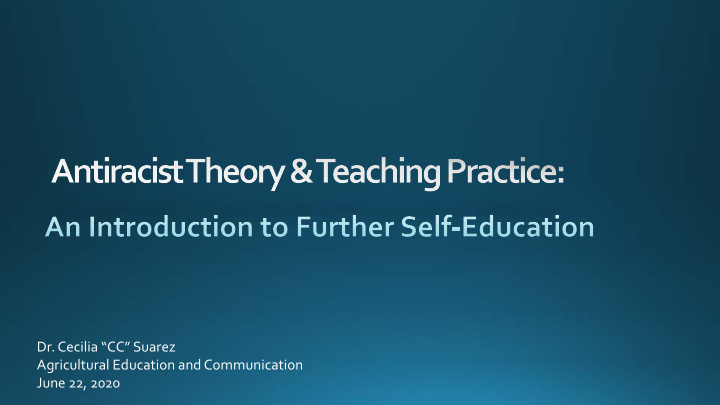



Dr. Cecilia “CC” Suarez Agricultural Education and Communication June 22, 2020
• Warm-Up • Identities • Cultural Relevancy • Privilege • Race & Critical Race Theory • Structures & systems • Antiracism • Challenges and Opportunities • Important Things to Remember • Q&A
Moment of reflection to hold space and acknowledge that individuals are experiencing multiple layers of harm, threats, stress, uncertainty, and overall emotion. 2 word check-in In chat, type 2 words to describe how you are feeling today.
Time Allotted: • 5-7 minutes SHARE WITH YOUR BREAKOUT Instructions: GROUP • Share the 3 most important things you do on a daily basis
What is identity? • Basic sense of who one is • Includes one’s beliefs and values • Conscious or unconscious affiliation: • Nationality • Region • Particular activities (sports, education, farming, etc.) Why is understanding our identities important for the work that we do?
Social Identities
Wearemore likelytosee theworld through ourown eyes andto assume thatothersseethe What does it mean to be culturally relevant? sameworldin thesame way we do. Culturally relevant practices “empowers students to maintain cultural integrity, while succeeding academically”. Dr. Gloria Ladson-Billings (1990) • Enables participants to relate workshop content to their cultural context • Alter curriculum, not individuals
Privilege There are many different types of privilege, not just skin color privilege, that impact the way people can move through the world or are discriminated against. -Born into, not things you earned, that afford you opportunities others may not have: • Citizenship • Class Does not mean • Sexual orientation -Haven’t worked hard for what you have • Sex -You should feel guilty or shameful • Ability • Gender DOES mean Recognizing Privilege simply means being aware that some people have to work much harder just to experience the things you take White Privilege “White privilege is an invisible package of unearned assets which I can for granted (if they ever can experience them at all.) count on cashing in every day, but about which I was meant to remain oblivious.” * Explaining white privilege to a broke white Peggy Macintosh, “Unpacking the Invisible Knapsack.” person
What if the fence was never there?
Critical Race Theory (CRT) *Race pervades every aspect of society. • Derrick Bell (Legal Scholar) • Used to analyze and critique programs, services, and systems. Intersectionality – Coined by Kimberlé Crenshaw Most Americans say it’s now more common for people to express racist or racially insensitive views; more than four-in- ten say it’s more acceptable (Horowitz, et al., 2019) – Pew Research Center
Structural and Systemic Racism : Normalization and legitimization of an array of dynamics – historical, cultural, institutional and interpersonal – that routinely advantage whites while producing cumulative and chronic adverse outcomes for people of color. Examples of Structures and Systems • Redlining/Housing Discrimination • School disciplinary actions • Criminal Justice System • Wealth distribution • Health care: Care & Infant mortality Raceforward.org –Video series
“I am not a racist” ≠ Antiracist Racist: One who is supporting a racist policy through their actions or inaction or expressing a racist idea (Kendi, 2019). Antiracist: One who is supporting an antiracist policy through their actions or expressing an antiracist idea (Kendi, 2019). • Must be actively working against racist structures • Unlearning • Sacrifice
Saying NOTHING is still saying SOMETHING
Microaggression …Breathing in smog in the air: "They're so pervasive in our environment that we're Subtle, verbal and nonverbal slights/insults, directed toward constantly breathing them in. And as a an individual due to their group identity, often automatically consequence of breathing them in, we should not and unconsciously. Usually committed by well-intentioned be surprised that sometimes we breathe that folks who are unaware of the hidden messages being out.” ~Beverly Tatum communicated. Common Microaggressions • “No, really, where are you from?” • “You don’t even sound like you’re from another country.” • “All lives matter.” • “I’m not racist; I have a black friend.” • “I don’t see color.” • Putting the work on people of color
• Comfort vs. Safety • The “F” word • No “one-size-fits-all” solution • Intent vs. Impact • ”I don’t know.”
Your proximity to Blackness doesn’t mean you are insulated from racism or no longer complicit in white supremacy.
Recommend
More recommend